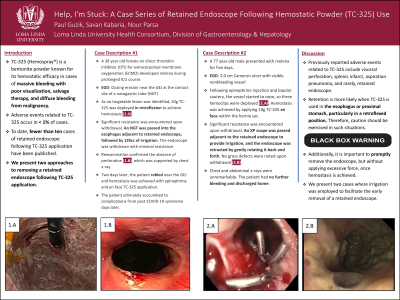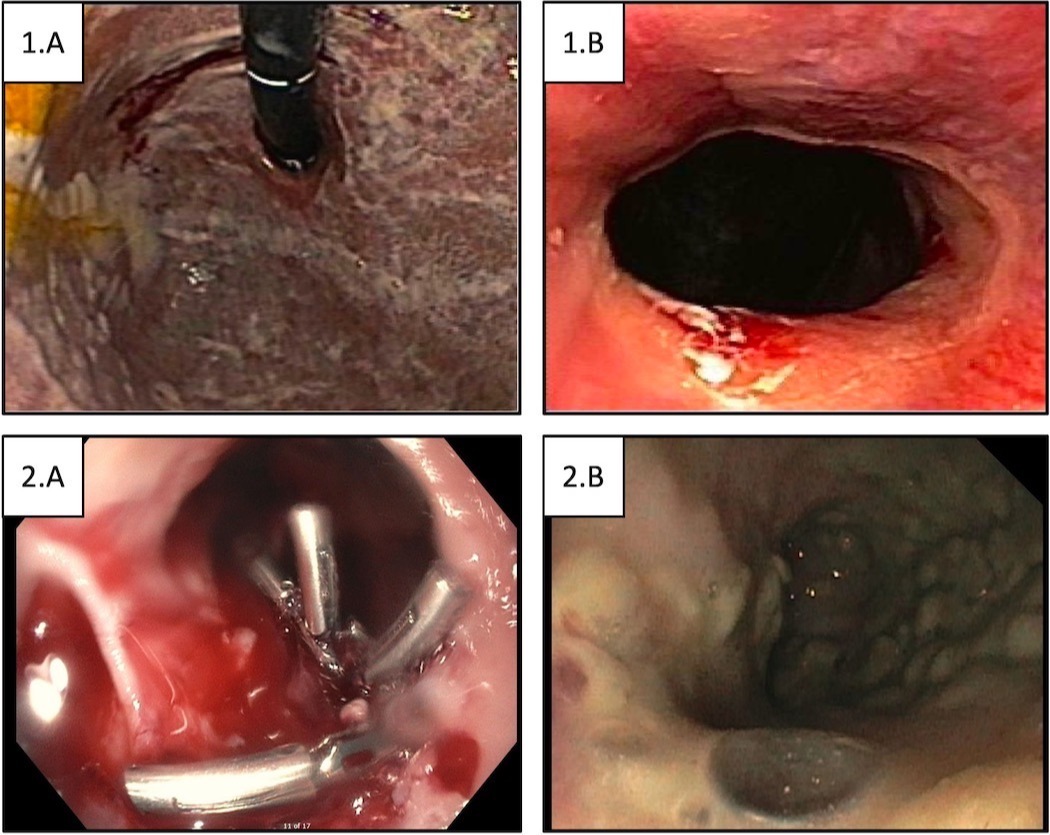Tuesday Poster Session
Category: General Endoscopy
P3418 - Help, I'm Stuck: A Case Series of Retained Endoscope Following Hemostatic Powder (TC-325) Use
Tuesday, October 24, 2023
10:30 AM - 4:00 PM PT
Location: Exhibit Hall

Has Audio

Paul Guzik, DO
Loma Linda University
Redlands, CA
Presenting Author(s)
Paul Guzik, DO1, Savan Kabaria, MD2, Nour Parsa, MD3
1Loma Linda University, Redlands, CA; 2Loma Linda University, Loma Linda, CA; 3Loma Linda University Health, Loma Linda, CA
Introduction: TC-325 is a bentonite powder known for its hemostatic efficacy in cases of massive bleeding with poor visualization, salvage therapy, and diffuse bleeding from malignancy. Adverse events related to TC-325 occur in < 1% of cases. To date, fewer than ten cases of retained endoscope following TC-325 application have been reported. We present two approaches to removing a retained endoscope following TC-325 application.
Case Description/Methods: A 38 year old female on direct thrombin inhibitor (DTI) for extracorporeal membrane oxygenation (ECMO) presented with melena. Esophagogastroduodenoscopy (EGD) revealed an oozing erosion near the gastroesophageal junction (GEJ) at the contact site of a nasogastric tube (NGT). As no targetable lesion was identified, 20g TC-325 was deployed to achieve hemostasis. During withdrawal, significant resistance was encountered. An NGT was passed into the esophagus, followed by 120cc of irrigation. The endoscope was withdrawn with minimal resistance. Reexamination confirmed the absence of perforation, which was supported by chest x-ray. Two days later, the patient rebled near the GEJ and hemostasis was achieved with epinephrine and en face TC-325 application. The patient succumbed to complications from post-COVID-19 syndrome.
A 77 year old male presented with melena for five days. On EGD, he had a 2cm Cameron ulcer with visible nonbleeding vessel. Following epinephrine injection and bipolar cautery, the vessel started to ooze, so three hemoclips were deployed. Hemostasis was achieved by applying 10g TC-325 en face within the hernia sac. Significant resistance was encountered upon withdrawal. An XP scope was passed adjacent to the retained endoscope to provide irrigation, and the endoscope was retracted by gently rotating it back and forth. No gross defects were noted upon withdrawal. Chest and abdominal x-rays were unremarkable. The patient had no further bleeding and discharged home.
Discussion: Previously reported adverse events related to TC-325 include visceral perforation, splenic infarct, aspiration pneumonia, and rarely, retained endoscopy. Retention is more likely when TC-325 is used in the esophagus or proximal stomach, particularly in a retroflexed position. Therefore, caution should be exercised in such situations. Additionally, it is important to promptly remove the endoscope, but without applying excessive force, once hemostasis is achieved. We present two cases where irrigation was employed to facilitate the early removal of a retained endoscope.

Disclosures:
Paul Guzik, DO1, Savan Kabaria, MD2, Nour Parsa, MD3. P3418 - Help, I'm Stuck: A Case Series of Retained Endoscope Following Hemostatic Powder (TC-325) Use, ACG 2023 Annual Scientific Meeting Abstracts. Vancouver, BC, Canada: American College of Gastroenterology.
1Loma Linda University, Redlands, CA; 2Loma Linda University, Loma Linda, CA; 3Loma Linda University Health, Loma Linda, CA
Introduction: TC-325 is a bentonite powder known for its hemostatic efficacy in cases of massive bleeding with poor visualization, salvage therapy, and diffuse bleeding from malignancy. Adverse events related to TC-325 occur in < 1% of cases. To date, fewer than ten cases of retained endoscope following TC-325 application have been reported. We present two approaches to removing a retained endoscope following TC-325 application.
Case Description/Methods: A 38 year old female on direct thrombin inhibitor (DTI) for extracorporeal membrane oxygenation (ECMO) presented with melena. Esophagogastroduodenoscopy (EGD) revealed an oozing erosion near the gastroesophageal junction (GEJ) at the contact site of a nasogastric tube (NGT). As no targetable lesion was identified, 20g TC-325 was deployed to achieve hemostasis. During withdrawal, significant resistance was encountered. An NGT was passed into the esophagus, followed by 120cc of irrigation. The endoscope was withdrawn with minimal resistance. Reexamination confirmed the absence of perforation, which was supported by chest x-ray. Two days later, the patient rebled near the GEJ and hemostasis was achieved with epinephrine and en face TC-325 application. The patient succumbed to complications from post-COVID-19 syndrome.
A 77 year old male presented with melena for five days. On EGD, he had a 2cm Cameron ulcer with visible nonbleeding vessel. Following epinephrine injection and bipolar cautery, the vessel started to ooze, so three hemoclips were deployed. Hemostasis was achieved by applying 10g TC-325 en face within the hernia sac. Significant resistance was encountered upon withdrawal. An XP scope was passed adjacent to the retained endoscope to provide irrigation, and the endoscope was retracted by gently rotating it back and forth. No gross defects were noted upon withdrawal. Chest and abdominal x-rays were unremarkable. The patient had no further bleeding and discharged home.
Discussion: Previously reported adverse events related to TC-325 include visceral perforation, splenic infarct, aspiration pneumonia, and rarely, retained endoscopy. Retention is more likely when TC-325 is used in the esophagus or proximal stomach, particularly in a retroflexed position. Therefore, caution should be exercised in such situations. Additionally, it is important to promptly remove the endoscope, but without applying excessive force, once hemostasis is achieved. We present two cases where irrigation was employed to facilitate the early removal of a retained endoscope.

Figure: 1.A First case: TC-325 deployed in retroflexion with hemostasis achieved
1.B First case: Reexamination of GEJ after retained endoscope was removed
2.A Second case: Ongoing oozing from Cameron ulcer site after epinephrine, bipolar cautery, and hemoclips
2.B Second case: TC-325 deployed en face within hernia sac with hemostasis achieved
1.B First case: Reexamination of GEJ after retained endoscope was removed
2.A Second case: Ongoing oozing from Cameron ulcer site after epinephrine, bipolar cautery, and hemoclips
2.B Second case: TC-325 deployed en face within hernia sac with hemostasis achieved
Disclosures:
Paul Guzik indicated no relevant financial relationships.
Savan Kabaria indicated no relevant financial relationships.
Nour Parsa indicated no relevant financial relationships.
Paul Guzik, DO1, Savan Kabaria, MD2, Nour Parsa, MD3. P3418 - Help, I'm Stuck: A Case Series of Retained Endoscope Following Hemostatic Powder (TC-325) Use, ACG 2023 Annual Scientific Meeting Abstracts. Vancouver, BC, Canada: American College of Gastroenterology.
